Exploring the Dynamics of Salt Water Experiments
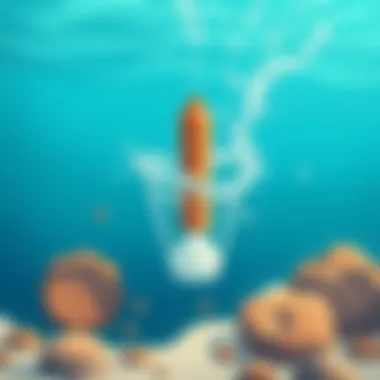
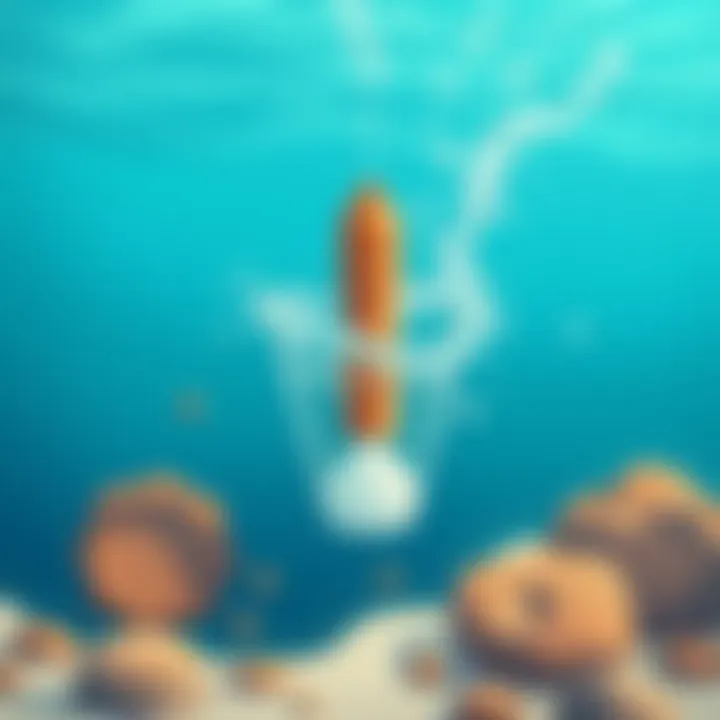
Intro
Many kids wonder why salt water has different properties compared to fresh water. This curiosity often leads to the delightful world of science experiments. Salt water experiments, in particular, provide a fascinating way to learn about key principles like buoyancy, density, and solubility. By understanding these concepts, young minds can grasp how things behave in the natural world—a skill that packs a punch in everyday life.
Beneath all this, there lies a wealth of knowledge just waiting to be uncovered. Salt water is more than just the ocean; it plays a critical role in our environment and influences various scientific fields. From environmental science to chemistry, these experiments can spark interest in broader scientific ideas. Imagine diving into a hands-on activity that not only illuminates scientific principles but also connects those ideas to the intricate workings of the earth.
With a sprinkle of salt, a few materials, and a curious mind, you can embark on a journey that blends fun and education. This guide offers detailed insights and practical steps to navigate through the exciting process of performing salt water experiments.
So, grab your lab coat—or at least your favorite apron—and get ready to explore what happens when salt meets water!
Science Fun Facts
Science is full of surprises, especially when it comes to salt water. Here are some fun facts that are sure to pique your interest:
- Did you know that roughly 97% of Earth's water is salty? The oceans house the majority of this water, which means we have only a tiny fraction available for drinking and use!
- Salt can help melt ice on roads in winter. It lowers the freezing point of water, making it easier to clear roads.
- The Great Salt Lake in Utah is one of the saltiest bodies of water in the world, boasting a salinity level that makes floating a breeze!
"Salt water is the world's best natural laboratory. Anyone can experiment with it and discover something new!"
Educational Concepts Unveiled
Several concepts come from salt water experiments, including:
- Buoyancy – This tells us how well an object can float in water. When salt dissolves in water, it increases the water's density, affecting how objects behave.
- Density – Understanding density helps explain why some items sink while others float. The more salt present, the denser the water becomes, which changes the buoyancy of different objects.
- Solubility – This is the ability of a substance to dissolve in a solvent. Salt is highly soluble in water, which provides a simple way to show how mixing works.
In a real-world application, these principles aren't just confined to a classroom. Environmental scientists use similar ideas to study ocean currents and marine life. Moreover, understanding salt water's role can also help with issues like melting ice caps, which impacts climate change.
Before jumping into hands-on experiments, let’s take a quick look at some resources that might help.
Useful Resources
Understanding these basic ideas forms a solid foundation for our experiments. It primes our minds to get curious and start questioning the world around us. Why does this float while that sinks? And what does salt even do?
Prelude to Salt Water Experiments
Understanding the properties and reactions of salt water is crucial not just for scientists but also for everyone curious about how things work in our environment. The subject of salt water experiments invites us to explore fascinating concepts like density, buoyancy, and solubility. This introduction emphasizes the significance of investigating these concepts, particularly for young science enthusiasts.
Understanding Salt Water
Salt water is more than just the ocean; it's a crucial component of various scientific phenomena. When table salt (sodium chloride) is dissolved in water, it creates a solution that behaves differently than fresh water. The presence of solute changes many properties, including the water's density and boiling point.
This transformation can lead to intriguing observations, such as objects floating or sinking based purely on their density relative to the saltwater. Kids often have a blast figuring out why some things float while others don’t—like when they drop a raw egg into salt water and watch it bob up instead of sinking. Salt water is a familiar example that makes the science behind it much more relatable and easier to grasp.
The Importance of Experiments
Experiments serve as the cornerstone of scientific understanding. They allow individuals—especially in elementary learning stages—to test hypotheses and gather data. Getting hands-on with a straightforward salt water experiment can inspire a deeper passion for science.
By engaging in activities like mixing salt with water, learners can visualize how solutions form and the impact of factors like temperature on solubility. Moreover, experimenting makes complex theories easier. Here are some notable benefits:
- Encourages Critical Thinking: Students begin to analyze and question what they observe.
- Fosters Teamwork: Working together on experiments enhances collaboration skills.
- Deepens Curiosity: The more they experiment, the more questions they might ask about the world around them.
"By understanding salt water experiments, learners not only grasp theoretical principles but also develop essential skills for scientific inquiry."
In summary, salt water experiments provide not just a glimpse into scientific principles but also create a pathway for young minds to follow their curiosity, paving the way for potential future discoveries in both chemistry and physics.
Scientific Principles Underlying Salt Water
Understanding the scientific principles underlying salt water is crucial for grasping the broader implications of experiments involving this unique solution. Salt water is not just any liquid; it possesses different characteristics compared to pure water due to the dissolved salts it contains. These differences lend to interesting observations during experiments, allowing us to explore complex scientific concepts such as density, buoyancy, and solubility more deeply.
These principles play a significant role in hands-on learning for students, educators, and curious minds alike. By digging into the mechanisms of salt water, we uncover the relationship between various elements, how they interact, and the real-world applications that stem from this knowledge. This is not just theoretical exploration; it has implications that extend to environmental science, everyday interactions, and industrial processes.
Density and Buoyancy Explained
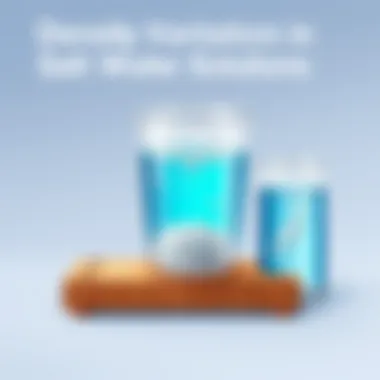

Density refers to how much mass is contained in a given volume. When you mix salt into water, you're packing more mass into the same space, which typically makes the liquid denser. This increase in density affects the buoyancy of objects placed in salt water. Buoyancy is the force that allows objects to float or sink in a fluid.
In straightforward terms, if you've ever seen a boiled potato bobbing in salt water while a fresh potato sinks, you're witnessing one of nature's little learning moments. The denser salt water pushes up on the boiled potato, providing enough force to keep it afloat, thanks to its altered density. Here’s how it plays out:
- Salt Water is Heavier: More particles are fighting for space in the water. Thus, when something floats, it’s because of this dense nature of salt water.
- An Easy Test: You can conduct a simple experiment at home - fill two bowls, one with fresh water and the other with salt water. If you place two eggs (one raw and one boiled) in each, watch how the boiled egg floats in salt water but sinks in fresh water.
This principle is not only important for science experiments but can also explain phenomena in nature like why ships can float on oceans, despite being heavy.
Solubility and Saturation Points
Solubility is a significant concept, too. It refers to the maximum quantity of a solute, in this case salt, that can dissolve in a given amount of solvent (water) at a specific temperature. This is crucial in understanding how salt interacts with water and the limits of its effectiveness in solutions.
When we talk about saturation points, we are essentially referring to the moment when the water can hold no more salt - that’s when it starts to accumulate at the bottom and not dissolve. Key aspects of solubility to bear in mind include:
- Temperature Effects: Generally speaking, warmer water can dissolve more salt than colder water. Ever tried to mix salt in hot water? It dissolves quickly, doesn’t it?
- Different Types of Salts: Not all salts behave the same way. For example, table salt (sodium chloride) has its unique saturation point compared to Epsom salt (magnesium sulfate).
- Real-World Ramifications: This knowledge isn’t just academic. It affects everything from cooking to the salinity levels in our seas, impacting marine life.
To sum it up: Understanding these principles of density and solubility lays a foundation for grasping broader scientific concepts and their practical applications.
As we continue to explore the effects of salt on water, we find ourselves at the intersection of science and daily life—an exciting space filled with endless opportunities for discovery.
For more insights into the science of solutions, consider visiting resources like Britannica, where you can dig deeper into these fascinating topics.
Materials Needed for the Experiment
Conducting a salt water experiment is not just about mixing salt and water. The materials you gather can greatly influence the results and overall experience. Having the right tools on hand ensures the experiment proceeds smoothly and safely, making it both engaging and educational for participants, especially for young learners.
By understanding the importance of various materials, we lay the groundwork for successful experiments. From precision tools to everyday items found around the house, each material can help simplify complex scientific concepts like density and buoyancy. The excitement of experimenting is amplified when children see the direct results of their actions, leading to a richer learning experience.
Common Lab Supplies
When it comes to salt water experiments, some laboratory supplies are must-haves. Here’s a straightforward list of common lab equipment:
- Beakers or clear plastic cups: These are perfect for mixing your salt and water, allowing you to observe any changes clearly.
- Stirring rods or spoons: To ensure the salt dissolves completely, a good stirring tool is crucial.
- Measuring spoons and cups: Accuracy goes a long way in experiments. Using these tools helps measure the exact amount of salt and water needed for the experiment.
- Thermometers: Knowing the temperature can be essential for understanding solubility and how it varies with temperature.
Using these lab supplies not only adds a visual element but ensures a more effective way of conducting the experiment, making scientific principles accessible to everyone involved.
Alternative Household Items
If laboratory supplies aren’t available, don’t fret; you can use various household items that work just as well. Here are some alternatives to consider:
- Glass jars or bottles: These can be repurposed for mixing and observing salt water compositions.
- Measuring cups from the kitchen: Any kitchen measuring tools can be handy to ensure accuracy even if they’re not labeled for lab use.
- Old spoons or chopsticks: If you don’t have stirring rods, these can help stir your mixtures effectively.
- Food coloring or small toys: These can be added for fun, helping visualize density and buoyancy through colorful representations.
Using household items not only makes experiments more accessible but also shows children that science is everywhere, even in their own homes.
"Science is about exploration. Sometimes, the best experiments come from improvisation and creativity."
By gathering the right materials, whether from a lab or your kitchen, your experiment will be ready to unfold all the exciting discoveries about salt water. This preparation showcases the importance of good organization in conducting scientific experiments, ultimately helping young learners engage with science more effectively.
Step-by-Step Guide to Conducting the Experiment
Conducting a salt water experiment is an enlightening journey into the heart of scientific exploration. This step-by-step guide breaks down every part of the process, providing clarity and structure to young science enthusiasts as well as their parents and caretakers. The importance of systematic execution cannot be overstated, as it lends itself to better understanding of scientific principles while also fostering a hands-on learning environment.
Whether it’s observing how salt dissolves in water or analyzing buoyancy effects, following a structured approach can enhance comprehension and retention of these concepts. In this part of the article, we will dissect each phase into digestible parts, making sure to highlight the benefits and considerations for conducting the experiment accurately and safely.
Preparation Stage
The preparation stage is truly where magic begins. It’s not just about gathering materials; it’s about setting the stage for discovery.
To kick things off, here's what you should do:
- Gather Your Materials: This includes salt, water, a clear container, and a measuring tool. Decide whether you’ll use table salt or sea salt, just keep in mind that different salts can have different properties.
- Choose Your Workspace: A well-ventilated area is ideal. If you’re doing this at home, it’s wise to select a spot that’s easy to clean.
- Read the Instructions Thoroughly: Just as one wouldn’t dive into the deep end without knowing how to swim, ensure you understand each step before proceeding.
The aim here is to ensure that your environment is safe and conducive to learning. Safety goggles aren’t necessary for this simple experiment, but it’s always good to prepare for the unexpected.
Executing the Experiment
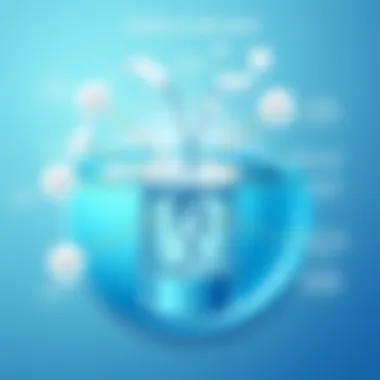
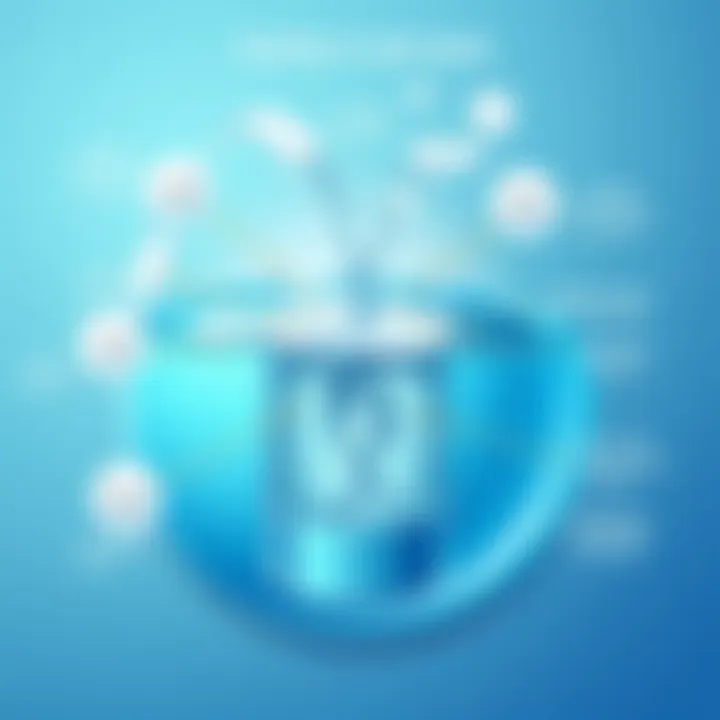
Once you’ve got your setup in place, the experiment can be executed smoothly. This is where the fun really begins as you bring theory to practice:
- Mixing Salt with Water: Slowly add salt to the water while stirring. Observe how the salt crystals dissolve. Note the point at which no more salt seems to dissolve, which indicates saturation.
- Experiment with Different Quantities: Play around with the amounts of salt and water. What happens when you add more salt than before? Does the water remain clear, or does it start to cloud up?
- Observe Buoyancy: If you're keen, drop different objects, like a piece of fruit or a small toy, into the solution after saturated. Note how they float or sink compared to plain water.
This segment encourages active participation, making hands-on learning a thrilling experience rather than a chore.
Observation and Data Collection
Observing and recording data is a crucial component of the scientific method. It’s how you glean insights from your experiment:
- Take Notes: Document every change, however minute. Describe how fast the salt dissolves or how object behaviour changes in the solution. You might want to grab a simple notebook for this task.
- Photograph Your Process: If possible, take pictures at different stages. Visual evidence supports your understanding and nurtures a keen eye for detail.
- Discuss Your Findings: After finishing, sit down and discuss what you’ve seen with your peers or family. Share your observations, as dialogue often sparks deeper understanding.
To highlight the essence of experimentation:
"In nature, everything is connected; observing one element often reveals truths about another."
Analyzing the Results
Analyzing the results of a salt water experiment is more than just a final step; it's the heart of scientific inquiry. In this section of our exploration, we emphasize the significance of not only collecting data but interpreting it with a keen eye. This analysis allows young scientists and their curious caregivers to draw meaningful conclusions from their experiments. Understanding the outcomes can also spark questions and deeper discussions about the broader implications of these findings.
Whether you’re talking about buoyancy, solubility, or density, every result tells a story. It reveals how salt interacts with water and how those interactions can be seen in real life. Thus, an insightful analysis encourages critical thinking, pushing young learners to become more engaged not just in this experiment, but in scientific thinking as a whole.
Discussing the Findings
When it comes to discussing findings, clarity is vital. During the experiment, data might emerge that shows how different quantities of salt affect the water's density or buoyancy. For instance, if a participant observes that an object sinks in plain water but floats in salt water, this is a significant finding. Young scientists can jot down these observations in a simple table. This could look like:
| Experiment | Result | Explanation | | Plain Water| Object sinks | Density of water is higher than object | | Salt Water | Object floats | Salt water's density is higher than object |
This straightforward presentation of findings helps break down complex scientific concepts into digestible pieces, making it easier for children to grasp the essence of their observations. Additionally, tying these findings back to their initial hypotheses is essential for cementing their understanding.
Understanding Anomalies and Errors
In any experiment, not all results will align with expectations. Recognizing anomalies is a crucial aspect of scientific analysis. Anomalies can arise from various factors such as measurement errors or unexpected reactions in the materials used. For example, if the same object floats in one test and sinks in another, this discrepancy needs to be addressed.
Understanding these errors is an opportunity for learning. Rather than getting discouraged, young scientists can treat these as puzzles to solve. Here are some considerations for examining anomalies:
- Re-examine the Procedure: Was the amount of salt measured accurately?
- Check the Materials: Were all items used in the experiment free from contaminants?
- Understand Environmental Factors: Did temperature play a role in the experiment?
To navigate these uncertainties, young learners can engage in further experiments or discussions. This encourages resilience and inquisitiveness—traits essential for any aspiring scientist. In recognizing and discussing anomalies, they not only gain a comprehensive understanding of the experiment but also cultivate a mindset that values inquiry and exploration.
"In science, there are no failures, just discoveries waiting to be made."
By meticulously analyzing results, discussing findings, and understanding anomalies, students and caregivers forge a path towards insightful scientific exploration. This discourse not only unravels the mysteries of salt water but also serves as a stepping stone to more advanced scientific concepts.
Real-World Applications of Salt Water Knowledge
Exploring the realm of salt water extends beyond the seas and scientific laboratories. The principles discovered through these experiments have wide implications that touch our daily lives, environmental systems, and industrial processes. Understanding how salt and water behave together helps us think critically about the world around us. Let us delve into two significant applications: environmental and industrial aspects.
Environmental Impact
Salt water experiments provide crucial insights that contribute substantially to environmental science. For instance, assessing the salinity in ocean waters and its effect on marine biodiversity is vital. The understanding gleaned from basic experimentation can lead to innovations in conservation efforts. This involves:
- Monitoring Ecosystems: Salt concentration affects not just marine plants and animals but also ecosystems. Higher salinity can wear down shorelines and affect fish populations. Through experiments, we can learn how to create environments that support marine life.
- Water Purification: Experimentation has shown methods for filtering and desalinating salt water, making it safer for drinking. This directly impacts communities that face fresh water shortages.
- Climate Studies: Salt water influences weather patterns and climate change. Conducting salt experiments gives researchers concrete data to understand these dynamics better.
"The ocean is the lifeblood of our planet, and its secrets can be unveiled through diligent scientific exploration."
Through these experiments, we not only gather knowledge but also prompt conversations about sustainability and the ongoing preservation of resources. The implications of understanding salt water extend well into environmental stewardship.
Industrial Usage
On the industrial front, salt water has profound applications that often go unnoticed. Scientists frequently engage in salt water experimentation to enhance various sectors:
- Agriculture: In agriculture, salt water helps determine which crops can withstand saline conditions. This enables farmers to cultivate in areas that may not have been possible. By conducting tests, we can support innovation in food production.
- Chemical Production: Industries utilize salt water in the manufacturing of chemicals like chlorine and sodium hydroxide. Experiments influence how these chemicals react, ensuring efficiency and safety in production processes.
- Renewable Energy: There is also potential in harnessing salt water for energy generation through processes like salinity gradient power. Exploring this area could lead to innovative, sustainable solutions.
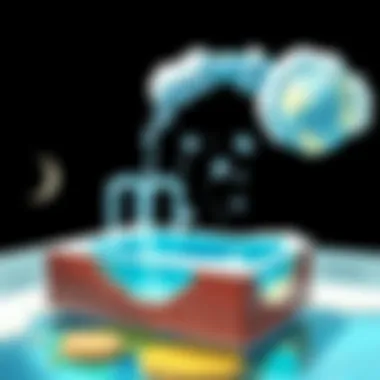

By understanding the roles salt water plays in everyday industries, we can appreciate its importance more deeply. The benefits stretch beyond merely scientific curiosity; they touch on global issues of food security, energy, and overall economic viability. This should drive educators and policymakers alike to facilitate meaningful access to such experiments and analyses.
Encouraging Further Exploration
Encouraging further exploration in the field of salt water experiments opens the door to a world brimming with potential discoveries. It is not just about learning facts; it’s about sparking curiosity and a sense of wonder in young minds. When children engage in science through concrete experiments, they begin to appreciate the intricate connections between science and everyday life. The beauty of salt water as a subject is that it’s readily available and easily manipulable, allowing one to experiment without fancy lab setups. This familiarity fuels interest, pushing young explorers to dive deeper into scientific inquiry.
Advanced Experiments with Salt Water
After grasping the basic principles of salt water through simple experiments, youngsters can move on to more intricate ones.
- Layered Density Experiments: By creating layers of different liquids, students can witness the effects of varying densities. They can mix salt water with sugar water and watch how they form distinct layers, directly visualizing the concept of density.
- Electrolysis of Salt Water: This fascinating experiment uses electricity to split saltwater into hydrogen and oxygen gases. With a simple battery and some electrodes, kids can see bubbles form and understand the process of chemical reactions. It highlights not only scientific principles but also the importance of salt water in our environment.
- Solar Salt Production: Have kids make their own sea salt by evaporating salt water from various sources, including sea, lake, or tap water. This practical project emphasizes the concept of evaporation and solubility while connecting to global salt production.
"The journey into advanced experiments can open up portals to discovery, leading students to explore deeper scientific phenomena."
These experiments not only solidify their understanding of the original concepts but also introduce new dimensions of scientific learning.
Connecting with Other Scientific Concepts
Linking salt water experiments with broader scientific concepts is essential for comprehensive learning. Salt water is not a standalone subject; it meshes well with topics ranging from environmental science to chemistry and physics.
- Water Cycle: Kids can relate the principles learned from salt water to the water cycle, gaining insights into evaporation, precipitation, and the role of salt in our oceans.
- Chemistry Basics: Understanding the ionic compounds present in salt water can enhance lessons on chemical bonding and reactions. Through experiments, they get to see theory become practice.
- Marine Ecosystems: Discussing the roles that salt water plays in marine life drives home the significance of environmental conservation. Salt water habitats like oceans and bays are critical for biodiversity and ecosystem balance.
Encouraging connections between these ideas cultivates a richer understanding of the world around us. Kids learn that science isn't a series of isolated facts; it all connects, forming a web of knowledge waiting to be unraveled. The more they know about salt water, the more they will see its impact on their lives and the world at large.
Safety Precautions in Conducting Experiments
Conducting salt water experiments can be a thrilling endeavor, but overlooking safety precautions can lead to unpleasant surprises. Whether you're a curious child diving into science or a parent overseeing the fun, understanding safety measures is crucial. It’s not just about avoiding accidents; it's about fostering a habit of caution in all scientific undertakings.
Understanding Risks
When working with salt water, even though it seems harmless, there are still risks to be aware of. For instance:
- Corrosive Effects: If you're using certain materials or chemicals alongside salt, they may be corrosive. Metal tools left in salt water can rust and degrade over time.
- Health Concerns: Allergies can pop up unexpectedly. Salt might not seem like an allergen, but people can react poorly to certain additives sometimes mixed in commercial salt.
- Slips and Falls: A simple spill can make surfaces slippery and lead to accidents. Water mixed with salt can create a slick floor, so it’s wise to keep your workspace tidy.
It's important to consider these risks carefully and not take the nature of the materials involved for granted. Remember, a little caution goes a long way.
Best Practices for Safe Experimentation
To ensure that your experiments unfold successfully, following some best practices is necessary. Here are a few simple tips:
- Wear Protective Gear: Always wear safety goggles to protect your eyes from splashes. Gloves can also be handy, especially if you’re using chemicals.
- Set Up a Safe Workspace: Choose a well-ventilated area to conduct your experiment. This will help avoid any build-up of potentially harmful vapors.
- Keep Materials Organized: Before you begin, gather all your materials and place them neatly. This reduces the risk of spills and accidents during the experiment.
- Supervision is Key: If children are helping out, ensure there’s an adult nearby to guide them and step in if something goes awry. Even the smallest of oversights can lead to mishaps.
- Know Emergency Protocols: Familiarize yourself with what to do in case of an emergency, like a sudden spill of salt or any unexpected reactions. Having a first-aid kit and knowing where it is can save a lot of trouble.
"Being prepared is half the victory."
Following these best practices not only helps keep experiments safe but also instills a sense of responsibility in young scientists. By prioritizing safety, the excitement of discovery remains untouched by avoidable hazards.
Ending: The Value of Salt Water Experiments
Conducting salt water experiments holds a wealth of significance for both young scientists and their mentors. The beauty of these scientific endeavors lies not only in the fascinating phenomena they reveal but also in how they bridge multiple scientific principles. By experimenting with salt water, individuals can gain insights into buoyancy, density, and solubility in a tangible way. These concepts may seem abstract in textbooks, but when explored through hands-on activities, they become much more approachable and understandable.
At the core of these experiments is the joy of discovery. Each observation and measurement provides a unique window into the physics and chemistry that govern our world. Salt water experiments can empower students with critical thinking skills as they analyze their findings and draw connections to real-life applications. For instance, understanding why certain objects float or sink helps explain phenomena in nature like the behavior of marine life, or the impact of pollution on water density.
Furthermore, these experiments encourage curiosity, which is essential for personal and academic growth. Little minds often ask big questions, and salt water experiments can serve as a springboard for further inquiry into environmental science, oceanography, and even meteorology. The connections made here are stepping stones toward more complex scientific exploration.
"Successful experimentation cultivates an environment of inquiry and motivation in learning."
In essence, the value of salt water experiments cannot be overstated. They encapsulate the essence of scientific inquiry, providing hands-on learning experiences that are both educational and engaging. As readers reflect on these experiments, the underlying message is clear: science is not just an academic subject but a lens through which to view and understand our everyday lives.
Reflecting on the Experiment Experience
Reflecting on the experience of conducting salt water experiments can be quite enlightening. For many students, this is their first taste of authentic scientific work. Through each step—from preparation to observation—participants are immersed in a systematic approach to learning. It’s where theory meets practice, and the results can be quite illuminating.
The simplicity of these experiments, using everyday materials, allows participants to connect what they learn in classrooms with real-world scenarios. When a child sees how sugar dissolves differently in warm water compared to cold, that immediate feedback can produce a spark of understanding that often eludes traditional learning methods. The result is an aha moment that can fuel a lifelong passion for science.
Inspiring Future Experimentation
Encouraging future experimentation is where the magic truly begins. Salt water experiments lay the groundwork for more advanced inquiries into various scientific fields. For example, once young learners grasp the basics of solubility, they might be keen to explore why certain substances dissolve faster than others. Or, they might wonder about the role salt plays in both natural ecosystems and human industries.
As they pair their newfound knowledge with curiosity, children are often inspired to design their own experiments. Perhaps they might decide to test the effects of various types of salt on the buoyancy of different objects. Such self-directed experiments can lead to original discoveries and deepen their understanding of scientific methodologies.
In fostering an environment that values exploration, we equip the next generation of scientists with the tools they need to not just understand the world around them, but to change it for the better.







